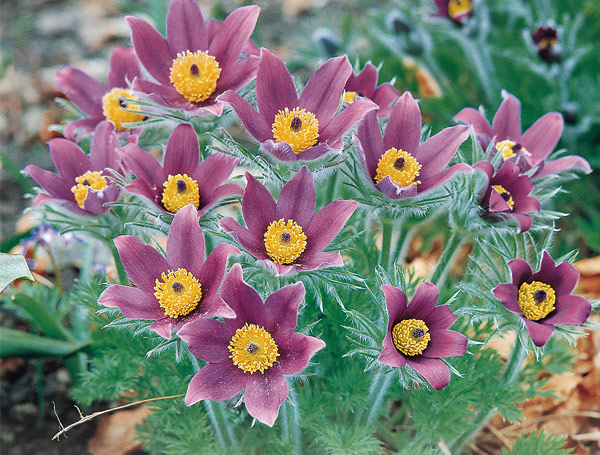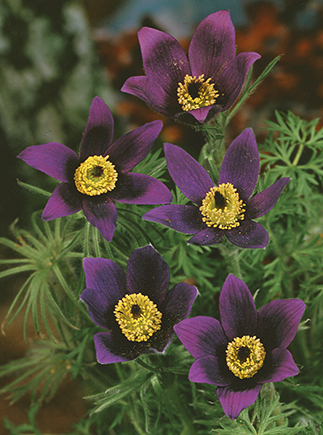
The spring days are growing longer, the birds are quickly emptying the feeders, and the flowers have begun to emerge. Bulbs like crocus and daffodils are in bloom, but in time, only the old, tattered foliage will remain. Some of the woodland wildflowers, like trillium and bluebells, are also in color, but they too will quickly disappear. Unlike so many early bloomers, pasque flower, will perform well in the spring and continue to be showy well into the summer.
Botanically referred to as Pulsatilla vulgaris, pasque flower sends up purple, reddish, pink or white 2-1/2 inch flowers in April and May. These flowers have 6 large petals (actually sepals) and a bright yellow center. After flowering begins, the spring leaves emerge and are equally showy. These leaves glisten with silky hairs that are exceptionally ornamental.

The performance has just begun, for when the spring flowers finish blooming, the seed pods form. These beautiful, silky, puff balls last well into the summer when all of the flowers have passed. The beautiful spring blossoms and clusters of seed pods make this an outstanding perennial for the front of the border or rock garden. Pasque flower grows 10 inches tall and 10 inches wide, and in our climate, it thrives in both full or partial sun. The plant will last for several years in most gardens, but performs best in a well-drained soil. Rarely does it suffer from insect or disease problems.
Pasque flower is somewhat difficult to find, but is well worth the effort. Young plants offered at garden centers quickly mature to showy clumps of vibrant flowers and striking foliage. ‘Rubra’ is the red form and the species is the purple form (just Pulsatilla vulgaris). These varieties are the easiest to locate, but I especially like the pink form, which, unfortunately, is rarely available. However, a more common German variety called ‘Papageno’ is a wonderful mixture which contains all colors, including the elusive pink.
Take advantage of the many features of this very underused perennial. Few spring-blooming perennials rival the extended display that pasque flower can provide. A tidy habit, wonderful flowers, and beautiful foliage are just some of the traits that make pasque flower a worthwhile addition to your garden.
Pasque flower
Botanical name: Pulsatilla vulgaris
Plant type: Perennial
Plant size: 10 inches wide and tall
Flower colors: Purple (most common), red, pink, or white
Flower size: 2-1/2 inches
Bloom period: April and May
Leaf colors: Silky green
Leaf size: Up to 6 inches long
Light: Full to partial sun
Soil: Prefers well-drained soil
Uses: Front of the perennial border or in the rock garden
Remarks: Leaves appear after the flowers. Silky hairs on the leaves make them glisten. Puffy seed heads form after the flower blooms are finished and are as attractive as the flowers.
George Papadelis is the owner of Telly’s Greenhouse in Troy and Shelby Township, MI.
Read more: Growing pasque flower from seed

Marilyn Hebert says
Although I have not planted Pasque Flower with pink petals, I have just found it growing throughout my grass for the first time. Is there seed from this flower that can travel some distance? Also, how do I get rid of it? It is still quite small, but from your description sounds like it will continue to grow much larger.
jhofley says
Marilyn, Although it can self seed, suddently finding pasque flower throughout your grass seems unlikely. What you are seeing may be something else. Take a sample to your local indpendent garden center or extension service for identification and advice on removal. Thanks for reading, Jonathon
https://www.fs.fed.us/wildflowers/plant-of-the-week/pulsatilla_patens_multifida.shtml